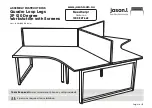
www.4rain.com
46 / 104
5 Installation
and
assembly
5.6 Laying
connections
Lay all inlet and overflow lines at a gradient of at least 1% in the direction of flow. Consider possible sub-
sequent settling.
The tank overflow runs through a preinstalled elbow. After connecting, check the correct positioning. The
elbow must point up.
In the case of multiple interconnected tanks, we recommend fitting the inlet and overflow lines to the one
tank. This minimises the transfer of floating/suspended matter and sediments to the other tanks. This
tank’s shaft cover must be accessible from ground level for cleaning work.
If the tank overflow is connected to a public sew-
age network, in accordance with DIN 1986, this
must be protected from backflow with a pump
(combined sewer) or antiflooding device (pure rain-
water pipe).
All intake, pressure, and control lines must be
routed in conduits. These conduits must be laid at
an angle to the tank, as straight as possible with-
out any sagging. Should elbows become neces-
sary, these should be moulded 30° pieces.
Important:
Connect the conduit to an opening
above
the max water level.
Fig. 31 – Recommended connections – example
with FLAT
Sewer
> 1 %
> 1 %
Summary of Contents for FLAT
Page 102: ...102 104 Notizen Notes Notas...
Page 103: ...103 104...
Page 104: ...104 104 943534 1 4 023122 287070...
















































